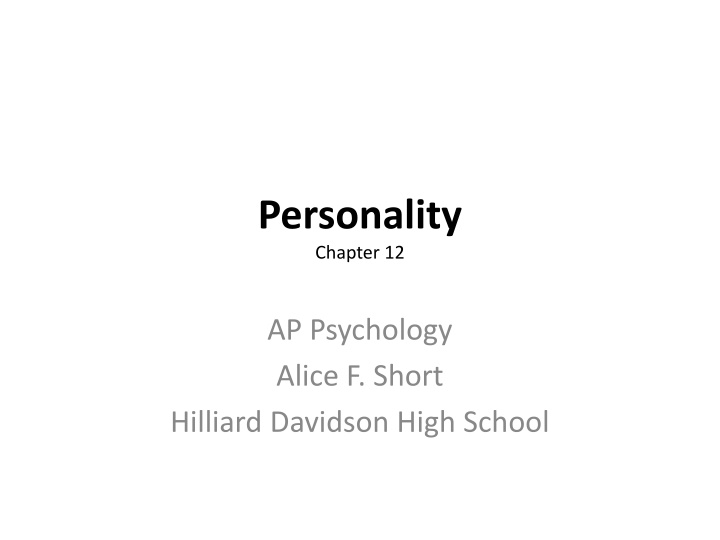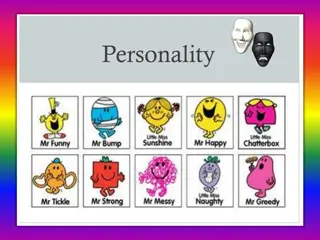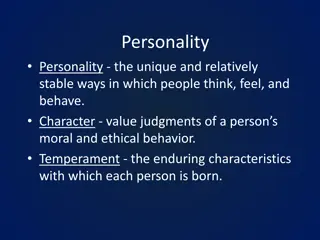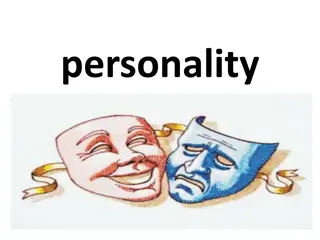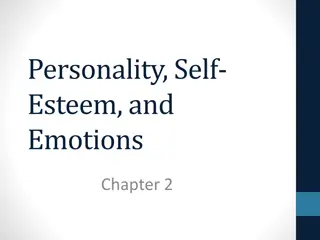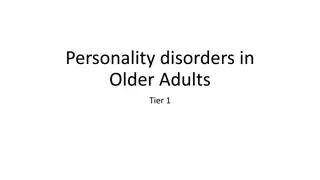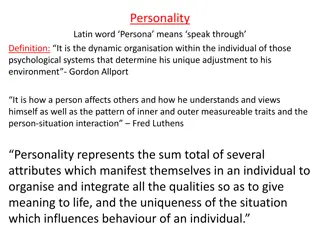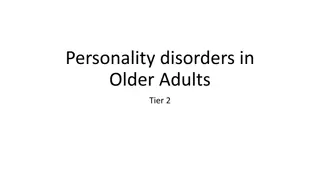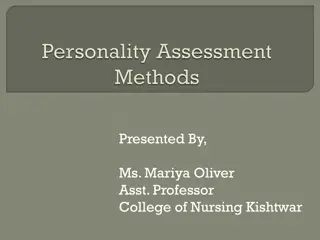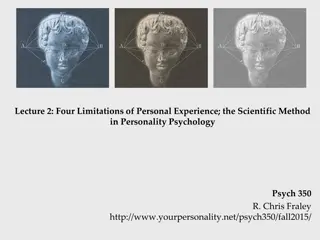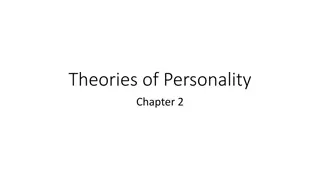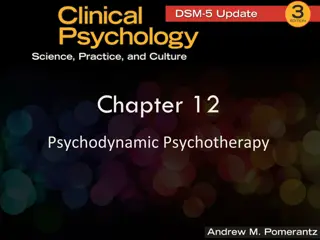Personality Through Psychodynamic Perspectives
Personality is a complex pattern of enduring thoughts, emotions, and behaviors that shape how individuals adapt to the world. The psychodynamic perspective, pioneered by Sigmund Freud, delves into the unconscious mind and early experiences to understand personality development. Freud, known as the founding father of the approach, believed in unlearned biological instincts influencing human behavior. His quotes reflect his deep insights into human nature, dreams, morality, and the mysteries of the mind.
Download Presentation

Please find below an Image/Link to download the presentation.
The content on the website is provided AS IS for your information and personal use only. It may not be sold, licensed, or shared on other websites without obtaining consent from the author.If you encounter any issues during the download, it is possible that the publisher has removed the file from their server.
You are allowed to download the files provided on this website for personal or commercial use, subject to the condition that they are used lawfully. All files are the property of their respective owners.
The content on the website is provided AS IS for your information and personal use only. It may not be sold, licensed, or shared on other websites without obtaining consent from the author.
E N D
Presentation Transcript
Personality Chapter 12 AP Psychology Alice F. Short Hilliard Davidson High School
Chapter Preview Psychodynamic Perspectives Humanistic Perspectives Trait Perspectives Personological and Life Story Perspectives Social Cognitive Perspectives Biological Perspectives Personality Assessment Personality and Health and Wellness
Personality personality - a pattern of enduring distinctive thoughts, emotions, and behaviors that characterize the way an individual adapts to the world
Psychodynamic Perspectives personality is primarily unconscious understanding personality involves exploring the symbolic meanings of behavior and the unconscious mind early childhood experiences sculpt the individual s personality
http://www.nndb.com/people/736/000029649/sigmund-freud-med.jpghttp://www.nndb.com/people/736/000029649/sigmund-freud-med.jpg Psychodynamic Approach: Freud Known as the founding father of the psychodynamic approach Believed that there are unlearned biological instincts (especially of a sexual and/or aggressive nature) that can occur early in life and these instincts influence how a person thinks, feels, and behaves Had a couch http://thegospelcoalition.org/blogs/tgc/files/2012/03/freud.jpg
http://www.philosophersimages.com/images/philosophers_images/freud/freud01.jpghttp://www.philosophersimages.com/images/philosophers_images/freud/freud01.jpg I cannot think of any need in childhood as strong as the need for a father's protection. The great question that has never been answered, and which I have not yet been able to answer, despite my thirty years of research into the feminine soul, is 'What does a woman want? Love and work are the cornerstones of our humanness. The interpretation of dreams is the royal road to a knowledge of the unconscious activities of the mind. America is the most grandiose experiment the world has seen, but, I am afraid, it is not going to be a success. Dreams are often most profound when they seem the most crazy. I have found little that is 'good' about human beings on the whole. In my experience most of them are trash, no matter whether they publicly subscribe to this or that ethical doctrine or to none at all. That is something that you cannot say aloud, or perhaps even think. Men are more moral than they think and far more immoral than they can imagine. Freud Quotes http://www.independent.co.uk/migration_catalog/article5234105.ece/ALTERNATES/w620/freud2.jpeg
Freuds Psychoanalytic Theory Freud and Psychoanalysis sex drive main determinant of personality development Hysteria physical symptoms without physical cause overdetermined multiple unconscious causes Iceberg Analogy of Human Personality
Personality Structure Freud
Personality Structure Id instincts and reservoir of psychic energy pleasure principle Ego deals with the demands of reality reality principle Superego moral branch of personality; conscience
A SHORT ACTIVITY Activity Handout 12.1 Rachel is walking to class and the late bell rang two minutes ago. As she walks into her class, she stumbles and her books go flying everywhere. Out of one of the books is a note to a boy that Rachel has secretly liked for a long time. The boy picks up the note and reads the top line and then hands it back to Rachel. She is so embarrassed. Id: Ego: Superego:
A SHORT ACTIVITY Activity Handout 12.1 Rachel is walking to class and the late bell rang two minutes ago. As she walks into her class, she stumbles and her books go flying everywhere. Out of one of the books is a note to a boy that Rachel has secretly liked for a long time. The boy picks up the note and reads the top line and then hands it back to Rachel. She is so embarrassed. Id: scream, runaway Ego: calmly collect belongings and proceed to class Superego: judge Rachel for being so foolish
A SHORT ACTIVITY Activity Handout 12.1 Jake is going on his first date with a really popular girl. He still can t believe that she agreed to go out with him. During the movie they are sitting so close that their legs are touching and he so badly wants to hold her hand and kiss her, but he isn t sure how she would react. He takes a chance and does it and she looks at him and then gets up and walks out. Id: Ego: Superego:
A SHORT ACTIVITY Activity Handout 12.1 Jake is going on his first date with a really popular girl. He still can t believe that she agreed to go out with him. During the movie they are sitting so close that their legs are touching and he so badly wants to hold her hand and kiss her, but he isn t sure how she would react. He takes a chance and does it and she looks at him and then gets up and walks out. Id: kiss her more Ego: apologize to her Superego: feel guilty
A SHORT ACTIVITY Activity Handout 12.1 Jessica is babysitting for the same family she baby sits for every Friday night. This Friday night, however, she invited her boyfriend over and they are snuggled on the couch, watching a movie. The parents come home early and find Jessica and her boyfriend wrapped in each others arms and sound asleep. They wake them up and are so upset because they felt as though Jessica was irresponsible. Jessica is really upset and not sure what to think or say. Id: Ego: Superego:
A SHORT ACTIVITY Activity Handout 12.1 Jessica is babysitting for the same family she baby sits for every Friday night. This Friday night, however, she invited her boyfriend over and they are snuggled on the couch, watching a movie. The parents come home early and find Jessica and her boyfriendwrapped in each others arms and sound asleep. They wake them up and are so upset because they felt as though Jessica was irresponsible. Jessica is really upset and not sure what to think or say. Id: spend more time with boyfriend Ego: apologize to the parents and promise not to do it again Superego: feel guilty
A SHORT Time to Ponder Small Group Discussion Do you think that the iceberg analogy works well to describe your personality. Why? Why do you think Freud came up with this personality structure with an id, ego and superego? How much do you think your childhood experience will influence your adulthood? How does Freud s definition of sex differ from other people s definitions? (reference textbook or notes)
A SHORT Task: Explaining the Id, the Ego and the Superego Activity Handout 12.2 Think of your three closest friends. Write down their names in the space provided and then put a check next to the space of the personality trait that your friend has. They can have more than one personality trait. After completing every one, go back, and in the space provided briefly explain what this tells you about your friends. Name: Neuroticism: ____ Extraversion: ____ Openness to Experience: ____ Agreeableness: ____ Conscientiousness: ____ Explanation: Pay special attention to this part! You will be discussing this with a neighbor and they will be evaluating how accurate you are.
Explaining the Id, the Ego and the Superego Activity Handout 12.2 Think of your three closest friends. Write down their names in the space provided and then put a check next to the space of the personality trait that your friend has. They can have more than one personality trait. After completing every one, go back, and in the space provided briefly explain what this tells you about your friends. Name: Neuroticism: ____ Extraversion: ____ Openness to Experience: ____ Agreeableness: ____ Conscientiousness: ____ Explanation:
Explaining the Id, the Ego and the Superego Activity Handout 12.1 Neuroticism: anxious, insecure, self-pitying Extraversion: sociable, fun-loving, affectionate Openness: Imaginative, interested in variety, independent Agreeableness: softhearted, trusting, helpful Conscientiousness: organized, careful, disciplined IN CLASS ACTIVITY: Trade and discuss with a neighbor to see if they successfully explained the characteristics. (Alternate between people)
Defense Mechanisms conflict between the id, ego, and superego results in anxiety defense mechanisms reduce anxiety by unconsciously distorting reality not necessarily unhealthy repression foundation for all defense mechanisms push unacceptable impulses out of awareness
Defense Mechanisms 1. repression 2. rationalization 3. displacement 4. sublimation 5. projection 6. reaction formation 7. denial 8. regression
Psychosexual Stages Oral Stage: 0-18 Months infant s pleasure centers on the mouth Anal Stage: 18-36 Months child s pleasure involves eliminative functions Phallic Stage: 3-6 Years child s pleasure focuses on the genitals Oedipal complex castration anxiety
Psychosexual Stages (cont.) Latency Stage: 6 Years - Puberty psychic time-out interest in sexuality is repressed Genital Stage: Adolescence and Adulthood sexual reawakening source of sexual pleasure is someone else fixation - remain locked in particular developmental stage (e.g., anal retentive)
Dissenters and Revisionists sexuality not pervasive force behind personality early experience not as powerful as Freud thought importance of conscious thought sociocultural influences
Dissenters and Revisionists Horney s Sociocultural Approach both sexes envy the attributes of the other need for security, not sex, is primary motivator Jung s Analytical Theory collective unconscious and archetypes Adler s Individual Psychology perfection, not pleasure, is key motivator
Evaluating Psychodynamic Theory Criticisms too much emphasis on early experiences too much faith in unconscious mind s control too much emphasis on sexual instincts theory can not be tested Contributions importance of childhood experiences development proceeds in stages role of unconscious processes
Humanistic Perspectives humanistic perspective - emphasis on a person s capacity for personal growth and positive human qualities
Humanistic Perspectives Abraham Maslow third force psychology self-actualization peak experiences biased since focus was on highly successful individuals
Humanistic Perspective Carl Rogers personal growth and self-determination unconditional positive regard conditions of worth self-concept empathy genuineness
Evaluating Humanistic Perspectives Contributions self-perception is key to personality consider the positive aspects of human nature emphasize conscious experience Criticisms too optimistic about human nature promotes self-love and narcissism
Trait Perspectives Trait an enduring disposition that leads to characteristic responses traits are the building blocks of personality Trait Theories people can be described by their typical behavior strong versus weak tendencies
Trait Perspectives Gordon Allport personality understood through traits behavior consistent across situations lexical approach 4500 traits W. T. Norman five factor model broad traits main dimensions of personality
Five Factor Model of Personality Do the big five show up in the assessment of personality in cultures around the world? Do the big five personality traits show up in animals?
Evaluating Trait Perspectives Contributions traits influence health, cognitions, career success, and interpersonal relations Criticisms ignores the role of the situation in behavior ignores nuances of an individual s personality
Personological Perspective personological perspective - focusing on an individual s life history or life story Henry Murray personology: the study of the whole person motives are largely unconscious thematic apperception test (TAT) need for achievement, affiliation, and power
Life Story Approach Dan McAdams our life story is our identity intimacy motivation Psychobiography applying personality theory to one person s life
Evaluating Life Story Approach Contributions rich record of an individual s experience Criticisms difficult and time-consuming extensive coding and content analysis prone to bias not easily generalized
Social Cognitive Perspective emphasize conscious awareness, beliefs, expectations, and goals incorporates principles from behaviorism when exploring: reasoning beliefs self reflection interpretation of situation
Social Cognitive Perspectives Albert Bandura reciprocal determinism behavior, environment, and cognitive factors interact to create personality Key Processes and Variables observational learning personal control self-efficacy
Self-Efficacy: Make a Life Change Activity Handout 12.3 Steps for Self-Efficacy Success: Select something you can reasonably expect to be able to do Don t be discouraged by past failure Pay attention to successes Keep written records of performance Make a list of situations that are both difficult and not difficult. Begin by tackling the less difficult.
Reciprocal Determinism
Social Cognitive Perspectives Walter Mischel Situationalism behavior and personality vary considerably across context CAPS Model of Personality stability over time rather than across situations interconnections among cognitions and emotions affect our behavior
Evaluating the Social Cognitive Theory Contributions focuses on interactions of individuals with their environments suggests people can control their environment Criticisms too concerned with change and the situation ignores the role of biology very specific predictions hinder generalization
Biological Perspectives Personality and the Brain brain damage alters personality brain responses correlate with personality Eysenk s Reticular Activation System Theory extraverts and introverts have different base-line levels of arousal Gray s Reinforcement Sensitivity Theory behavioral activation system and behavioral inhibition system
Biological Perspectives Role of Neurotransmitters growth of dopamine receptors stimulated by warm care-givers disposes person to reward-sensitivity (extraversion) less serotonin in circulation leads to negative mood (neuroticism)
Biological Perspectives Behavioral Genetics twin studies reveal substantial genetic influence on Big Five traits most traits influenced by multiple genes Evaluating the Biological Perspective ties personality to animal learning, brain imaging, and evolutionary theory criticisms (e.g., biology may be the affect, not the cause, of personality)
